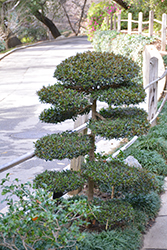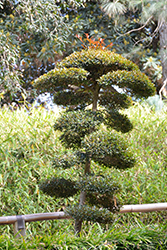Fri & Sat 8am - 8pm
Sun 8am - 7pm
Anytown, USA 12345
fax: 261.787.0463
e-mail: info@successgc.com


Plant Finder

Magenta Cherry Topiary
Syzygium paniculatum (topiary)
Height: 6 feet
Spread: 4 feet
Sunlight:
![]()
![]()
Hardiness Zone: 9b
Other Names: Brush Cherry, Magenta Lilly Pilly
Description:
An excellent choice to maintain as a garden accent because of its fast, dense growth; young leaves are coppery bronze, maturing to deep glossy green; attractive white flowers in spring or summer followed by edible berries in fall
Ornamental Features
Magenta Cherry Topiary features showy white pincushion flowers at the ends of the branches from mid spring to mid summer. It has attractive dark green evergreen foliage which emerges brick red in spring. The small glossy pointy leaves are highly ornamental and remain dark green throughout the winter. The fruits are showy red drupes carried in abundance from late summer to late fall. The fruit can be messy if allowed to drop on the lawn or walkways, and may require occasional clean-up. The rough khaki (brownish-green) bark is extremely showy and adds significant winter interest.
Landscape Attributes
Magenta Cherry Topiary is a dense evergreen dwarf tree with a strong central leader and a stunning habit of growth which features almost oriental horizontally-tiered branches. Its relatively fine texture sets it apart from other landscape plants with less refined foliage.
This dwarf tree will require occasional maintenance and upkeep, and can be pruned at anytime. It is a good choice for attracting birds to your yard. It has no significant negative characteristics.
Magenta Cherry Topiary is ideal for use as a garden accent or patio feature, and is recommended for the following landscape applications;
- Accent
- Topiary
- Container Planting
Planting & Growing
Magenta Cherry Topiary will grow to be about 6 feet tall at maturity, with a spread of 4 feet. It tends to be a little leggy, with a typical clearance of 1 foot from the ground, and is suitable for planting under power lines. It grows at a fast rate, and under ideal conditions can be expected to live for 60 years or more. This is a self-pollinating variety, so it doesn't require a second plant nearby to set fruit.
This dwarf tree does best in full sun to partial shade. It prefers to grow in average to moist conditions, and shouldn't be allowed to dry out. This plant should not require much in the way of fertilizing once established, although it may appreciate a shot of general-purpose fertilizer from time to time early in the growing season. It is not particular as to soil pH, but grows best in sandy soils, and is able to handle environmental salt. It is somewhat tolerant of urban pollution. This species is not originally from North America.
Magenta Cherry Topiary makes a fine choice for the outdoor landscape, but it is also well-suited for use in outdoor pots and containers. Because of its height, it is often used as a 'thriller' in the 'spiller-thriller-filler' container combination; plant it near the center of the pot, surrounded by smaller plants and those that spill over the edges. It is even sizeable enough that it can be grown alone in a suitable container. Note that when grown in a container, it may not perform exactly as indicated on the tag - this is to be expected. Also note that when growing plants in outdoor containers and baskets, they may require more frequent waterings than they would in the yard or garden.

